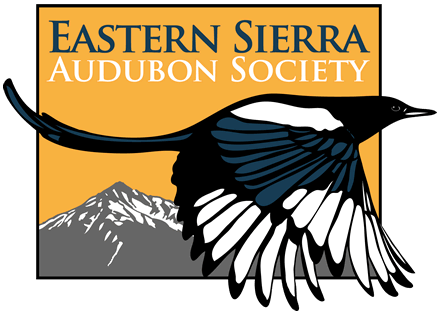From dawn until almost dusk twenty-one observers covered the Owens Valley, White Mountains, eastern Sierra canyons, and Death Valley, searching for all the birds they could find. The goal of the day was to see how many different species of birds could be seen in one day. Some interesting statistics: 180 (up 15 from last year) different species were found totaling over 7100 (up 827 from last year) individual birds; of the 180 species 134 (up 7 from last year) were neotropical migrants, that is, birds who spend the winter in Mexico, Central and South America and the Caribbean and migrate north to breed in Alaska, Canada, and North America; most common bird was the European Starling (360) followed closely by the Cliff Swallow (350). About 195 observer hours were recorded which is like one observer looking for birds for 195 hours or over 8 straight days and nights! Thirty species seen this year were new to the count as they were not seen last year, our first count. Thirteen species were seen in larger numbers than ever recorded before: Turkey Vulture (199), Rock Dove (114), Black-chinned Hummingbird (75), Nuttall’s Woodpecker (10), Dusky Flycatcher (31), Steller’s Jay (55), Cassin’s Vireo (26), Warbling Vireo (25), Townsend’s Warbler (91), Western Tanager (87), Black-headed Grosbeak (82), Bullock’s Oriole (87), and Lesser Goldfinch (123).
Each town had a team and each town turned up some interesting birds that none of the other teams had. The Lone Pine team, made up of Tom Heindel, Bob & Barb Toth, and Shawn Morrison had sixteen species that no other team recorded: Mountain Quail, Virginia Rail, Western Sandpiper, Least Sandpiper, Red-necked Phalarope, Bonaparte’s Gull, Ring-billed Gull, Barn Owl, Great Horned Owl, Northern Pygmy-Owl, Long-eared Owl, Common Poorwill, Ladder-backed Woodpecker, Oak Titmouse, Cactus Wren, Nashville Warbler, and Scott’s Oriole. The Independence team, made up of Leah & Andrew Kirk, Bob Hudson, and Larry Nahm, were the only ones to find Least Bittern and Townsend’s Solitaire.
The Big Pine team, made up of Jo Heindel, Earl & Carolyn Gann, Penny Ashworth, Stan Kleinman, and John & Ros Gorham, were the only ones to see Western Grebe, Redhead, Greater Yellowlegs, Broad-tailed and Rufous hummingbirds, Pinyon Jay, Juniper Titmouse, Mountain Bluebird, Indigo Bunting, and Lincoln’s Sparrow.
The Bishop team, made up of Jim & Debby Parker, John Finkbeiner, and Chris Howard were the only ones to find Great Egret, Black-crowned Night-heron, Canada Goose, American Wigeon, Ring-necked Duck, White-tailed Kite, Red-shouldered Hawk, Belted Kingfisher, Red-breasted Sapsucker, Bank Swallow, White-breasted Nuthatch, Pygmy Nuthatch, Marsh Wren, Swainson’s Thrush, Sage Thrasher, Virginia’s Warbler, Harris’s Sparrow, Gray-crowned Rosy-Finch, and Pine Siskin.
The Death Valley team, made up of Judy Wickman and Mike Prather were the only ones to find Verdin, Lucy’s and Black-and-white warblers.
The bad news is that we found 299 (up from 176 last year) Brown-headed Cowbirds. Some quick math. If half were females and each female lays 30 eggs this season (the accepted average) 4500 cowbird eggs will be laid. If a cowbird egg is added then most or all of the host species are dumped out of the nest by the newly hatched cowbird, pecked to death when hatched, or die from starvation while their parents feed the bigger mouth. Most female cowbirds will not lay an egg in a nest already containing a cowbird egg so each cowbird egg results in the death of most or all of the host young. Using the range of eggs per nest as 3-6, normal for small song birds, the cowbirds are insuring that 13,500-27,000 passerines like Willow Flycatcher, Yellow Warbler, Blue-gray Gnatcatcher, Yellow-breasted Chat, etc. will not be raised this year so that 4500 cowbirds can be. Mankind was responsible for introducing cowbirds into this area and should also be responsible for controlling the cowbird population so that we will have birds to look at besides the brown-headed wonder bird.
Tags: crow, dove, duck, egret, finch, flycatcher, gnatcatcher, grebe, grosbeak, gulls, hawk, heron, hummingbird, oriole, owl, sandpiper, sparrow, thrasher, thrush, vireo, vulture, warbler, wren
